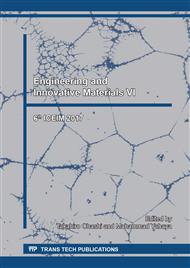p.286
p.292
p.297
p.302
p.307
p.312
p.318
p.325
p.332
Adsorption of Congo Red Dye on HDTMA Surfactant-Modified Zeolite A Synthesized from Fly Ash
Abstract:
Adsorption of anionic dyes Congo Red (CR) on HDTMA surfactant-modified zeolite A has been studied. The zeolite A, which is synthesized from coal fly ash, was modified with surfactant hexdeciltrimethylammonium bromide (HDTMA-Br) as much as 200% cation exchange capacity (CEC) of the zeolite. The effect of pH, contact time and initial concentration on the CR adsorption has been evaluated.The adsorption was carried out in a batch reactor at various pH, contact time and initial concentration on the given temperature. The amount CR adsorption varies as a function of pH, contact time and initial concentration of solution. Adsorption model of Langmuir and Freundlich from empirical data is used for this experiment. The Langmuir isotherm is more suitable for this adsorption. The experimental data fulfilled pseudo second-order kinetic models. The surfactant-modified zeolite A is more effective than zeolite A without modified on the adsorption of CR in aqueous solution.
Info:
Periodical:
Pages:
307-311
Citation:
Online since:
January 2018
Authors:
Keywords:
Price:
Сopyright:
© 2018 Trans Tech Publications Ltd. All Rights Reserved
Share:
Citation:


